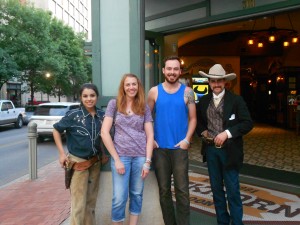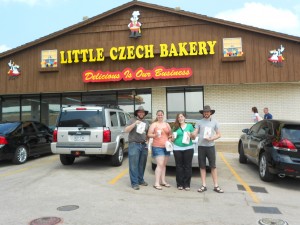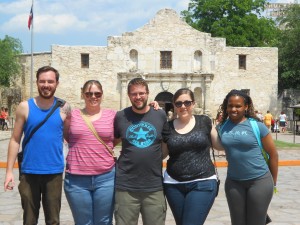We have two native Texans in our group. To the 49 other states that comprise the United States of America, this doesn’t mean much. However, as a Wisconsinite who has traveled actually quite a bit, and an anthropologist, this phenomenon in Texas is absolutely worth a brief post. Bear with me, this is my first foray into ethnographic writing.
- Ethnography: a research method designed to explore cultural phenomena where the researcher observes society from the point of view of the subject of the study. Data collection methods are meant to capture the “social meanings and ordinary activities” of people (informants) in “naturally occurring settings” that are commonly referred to as “the field.” (Definition courtesy of Wikipedia)

natural habitat.
I woke up this afternoon in a different country. It wasn’t intentional, and it was only half expected. I was in Texas.
Since I had soundly slept on each airplane since we first boarded in Indianapolis, including the layover in Dallas, I had missed the gradual transition from flip flops and baseball hats to cowboy boots and Stetsons. I shouldn’t have. One of our Texans (Ryan) wore his pointy, heel-clicking kickers on the plane. Our other native Dr. Latham didn’t. Truly, before this trip, I would have considered her a domesticated Texan. Domesticated Texans are those that blend in outside of Texas, almost like normal people.

The excitement of preparing and returning to Falfurrias had overshadowed the impending cultural shock. Texas requires an acclimation period of all irregular visitors. Everything really is bigger in Texas. Last year, we flew into Dallas and drive almost twelve hours to get to Falfurrias. Who knew Texas was so vast? At the sacrifice of the delicious Czech kolaches from West, Texas, this year we flew into San Antonio which is a short two-or-so hour jaunt to Falfurrias.
Our native Texans started our first day almost normally. It was difficult to believe we were in a different country. We stopped for lunch and were introduced to two of many things Texas does exceptionally well: beef and tacos. It appears the natives are exceptionally fond of tacos. (I will research this more: Are all Texans fueled by tacos?) Non-native Erica also appeared to immensely appreciate the tacos. It was a great meal with a feisty server who managed to convince native Dr. Latham her school-issued credit card was no good (he lied!) But, hey, go big or go home in Texas.

The bulwark of resistance, the Alamo, was our next stop. Native Ryan insisted on blending in with the tourists and awkwardly photographing our group in various poses. Was this an ingrained desire to make tourists feel more welcome in Texas? Or some other motivator I have yet to decipher? This seems normal behavior for him, and native Dr. Latham as well. After further observation, maybe Texans are naturally inclined to excessively photo-document. The same phenomena occurred along the scenic San Antonio Riverwalk.
Though only at the beginning of this ethnographic study, I have been told to watch for several classic Texan sightings including big, big hair, the taller the better for women, and gleaming belt buckles for both sexes. These are probable status symbols in this culture. Also a propensity for dancing, either in something called a “Texas two-step” (how is it called a dance with only two steps?) or with many people standing in a line together (line-dancing, I think they call it). Overall, this trip is already gearing up to be a very promising cultural experience in this country called Texas.

Disclaimer: At last census, Texas is still a member of our great nation, the United States of America. I always enjoy all time spent in Texas.